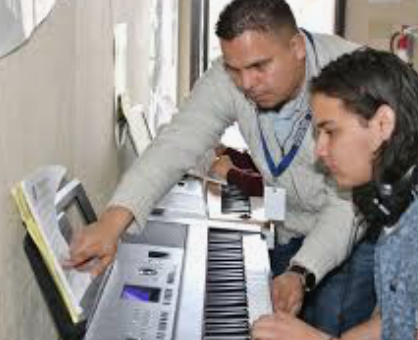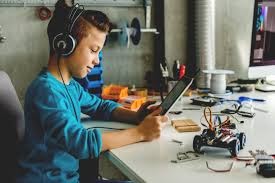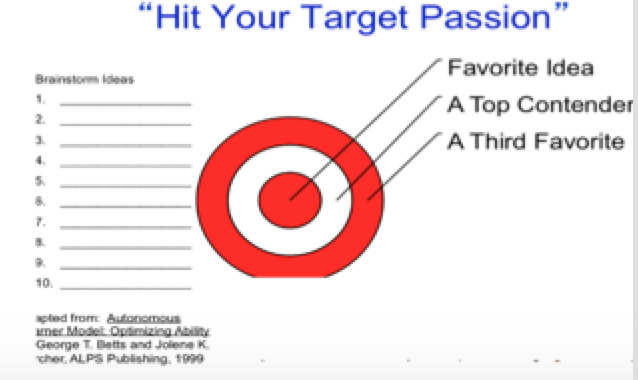Strategies to Support Strengths-Based Learning
| Site: | Colorado Education Learning Management System |
| Course: | 2e (Open Access) Supporting Twice Exceptional Learners |
| Book: | Strategies to Support Strengths-Based Learning |
| Printed by: | Guest user |
| Date: | Saturday, 6 December 2025, 3:27 AM |
Table of contents
- Strategies for the Intellectual Environment
- Modifications to the Physical Learning Environment
- A Supportive Emotional Environment
- Building Strengths Through Investigations
- Strengths-Based Classroom Strategies for Teachers
- Serving CLD Students Through Strengths
- Strengths-Based Strategies for Students
- SMART Goals for 2e Students
Strategies for the Intellectual Environment
Susan Baum, Robin Schader and Steven Owen created a very comprehensive resource in their book: To Be Gifted and Learning Disabled: Strength-Based Strategies for Helping Twice-Exceptional Students. One of the many things they focused on was creating responsive environments in the following domains:
- Intellectual Environment
- Modifications to the Physical Learning Environment
- Creating a supportive Emotional Environment
The following are a few of their strategies suggested for each of these areas:
Intellectual Environment
- Consider offering appropriate entry points to engage students:
- Provide Performance-based Assessments with differentiated exit points
- Investigating Authentic Problems:
- Integrating Critical and Creative Thinking:
•Elicit unusual or creative answers
•Creative Problem Solving (Eberle& Stanish, 1996) is six-step procedure that guides through idea generation to problem solution
Baum, Schader, Owen 2017
Modifications to the Physical Learning Environment
Flexibility is key when working with our 2e population. Discuss options with students and include them in experiments to learn which conditions help them learn best.
The following modifications are suggested:
Baum, Schader, Owen 2017
If you are interested in flexible seating, the following article by Chris Wjer: Flexible Seating: What's the Point provides some ideas to think about. http://chriswejr.com/2018/07/20/flexible-seating-whats-the-point/
A Supportive Emotional Environment
Create a supportive emotional environment using the following strategies:
Baum, Schader, Owen 2017
Building Strengths Through Investigations
Remember: Twice-Exceptional Students Need to Explore and Build Strength Areas:
Lesson 3 introduced how important it is to focus on students' strengths and interests. In this lesson, we'll again reinforce why a strength-based focus is important and offer another way to create learning opportunities to tap into this highly-motivating strategy.
Richard Olencheck, one of the most prominent leaders in gifted education, states: To overlook creative development in students who are Twice Exceptional is to deny them the necessary educational provisions they not only need but also deserve. To do otherwise is to reduce learning to an exercise in remediation wherein only the disabilities seem to matter while areas of giftedness and talent are marginalized if not completely disregarded. Such an educational program is negligent and certainly shortsighted, and both the child as s/he matures and the larger society lose out (Olenchak, 2017).
Many other researchers also argue that talent development is the most crucial component of the education of 2e students (Reis, 2014).
Normally, it is difficult to find the time for students to discover their passions within the regular allotted curriculum day. Flexible online learning necessitated by COVID-19 may allow the time students need to explore concepts and ideas that they want to know more about.


Structuring Student Interest Studies
Getting Started: Some Non-Negotiables
Projects that involve independent studies, and problem-based learning aren’t new--they have been around for a long time, however when we look at our twice-exceptional learners, it is also important to take into account their social/emotional needs as well as disability/challenge areas. It is critical that the student is the one who determines the area of study and how the investigation will proceed with guidance. 2e students need flexibility in the choice of topic and a chance to work independently on something that is of interest to them.
Develop A Plan for Student Investigations
Step 1: Identify an interest or passion area
Some learners have been waiting a lifetime to be able to study an area of interest in school while others won’t have a clue what they want to learn about. Start with the simple question of “What do you want to know more about?” Some students are going to need time to explore while others may have resources at their fingertips! Have the student begin by doing some personal investigation about what they would like to know more about--they will need time and an opportunity to investigate as well as guidance. This link to resources for student projects provides several suggestions to help students identify their passion/interest area to study.
One example is provided from the Autonomous Learner Model Resource Book.

Step 2: Organize Thinking and Research
Organization is often a struggle for 2e students. There are many ideas for this, however it needs to work for the student. One resource: the Independent Investigation Method for students k-12 provides a step-by-step guide for doing research
Step 3: Monitor Progress
If the student is engaged in how the project is monitored and assessed there is an embedded element of ownership. Student logs provide a brief description of the elements in the project including timelines for completion and presentation plans. Suggestions for log content are in the resource document.
Step 4: Share Results with an authentic audience
Finding a creative way to share investigations is important. The Product Choices Chart created by Susan Winebrenner (2014) provides a resource to share their research in meaningful ways.
Step 5: Assess the project work
Some assessment tools to consider include: project planners, logs and weekly self-evaluations. A student/teacher created rubric ensures the student knows what expectations are. Connecting the work done on projects to standards provides relevance for what they are learning in the classroom.
As educators, we feel a tremendous obligation to make sure we are following curriculum. Providing the opportunity for a student to investigate and develop their strengths and passions may feel as if they are neglecting the key elements of their learning. Going back to the rigor, relevance and relationships that 2e students need, this is an opportunity to find their strengths. This is not meant to be a replacement of curriculum, but rather a way to integrate and enhance the skills required.
Strengths-Based Classroom Strategies for Teachers
"Strength-Based Classroom Strategies for Teachers"
(credit (Rawana, E., Latimer, K., Whitley, J. & Probizansk, M., 2009.)
Every teacher attempts to create an environment that is optimal for learning, yet finding useful strategies for positive classroom management is a constant challenge. In the following article, you will find some useful and practical strategies for incorporating strength-based interventions to help when managing some of the most challenging behaviors.
The article begins with another perspective on understanding student strengths, then moves into discussion on the following topics:
- Teachers can help students to learn to use their strengths to deal with their struggles
- How to use strengths to shape, organize, manage and plan your classroom
- Applying student strengths to group activities in the classroom
- How to design a strength-based classroom environment
- How a strength-based classroom can encourage students to become consistent learners (engagement)
- Strength-based rules and routines
- What you stand to gain by using strength-based classroom strategies
Take about 5 minutes to look over this article on pages 16 - 17 of Canadian Teacher.
Serving CLD Students Through Strengths
The NAGC Position Statement on Identifying and Serving Culturally and Linguistically Diverse Gifted Students (CLD) focuses on four pertinent issues in order to meet the needs of our CLD population and emphasizes the need for a change in how educators view CLD students. A multi-dimensional paradigm shift from a deficit to a strength perspective is proposed to ensure the unique abilities of these students are recognized.
- Culturally Sensitive Identification Protocols
- Early and Continuous Access to Advanced Curriculum
- Essential Supports for CLD Gifted Students
- Effective Home, Community, and School Connections
Take a moment to read the NAGC position statement on CLD at this link
Strengths-Based Strategies for Students
Strength-Based Learning Strategies for Special Needs Students
Thomas Armstrong author of Neurodiversity in the Classroom: Strength-Based Strategies to Help Students with Special Needs Succeed in School and Life states: From the earliest days of research on learning disabilities, a multisensory strategy has been viewed as perhaps the best instructional intervention to use with students who have trouble reading and writing (see, for example, Slingerland, 1996). As students learn their letters and sounds, have them form letters in clay or with pipe cleaners, draw them on pavement with chalk, trace them in sandpaper, or manipulate them using colored blocks or tiles. Capitalizing on their strong visual-spatial skills, suggest that students write captions for photographs or draw storyboards to show their understanding of the sequence of a story. To enhance reading comprehension, tell students to close their eyes and visualize what they have just read. Some students have even found that the use of colored overlays or special lenses improve their perception of words (Williams, Kitchener, Press, Scheiman, & Steele, 2004). Reading materials should be chosen with a student's interests in mind.
A student who enjoys mathematics, for example, might like to read Counting on Frank by Rod Clement, while a student who is fascinated with insects might enjoy Matthew Reinhart's Young Naturalist's Handbook: Insect-lo-pedia. To personalize learning, show students how to take their dictated material from speech-to-text software and transform it into a book that could then be catalogued in the school library. If students exhibit music as a special strength, have them use percussion instruments to tap out the syllables of words or use singing or chanting to turn phonemes into musical sounds. This is especially helpful in addressing the phonological difficulties that many individuals with learning disabilities face (Overy, 2003). Here are some additional strength-based strategies to use with students who have learning disabilities:
- Use video to teach specific content.
- Provide students with a camera or camcorder to record their experiences.
- Draw pictures or use graphic organizers to illustrate concepts or content (see the Education Oasis website for a selection of 58 possible graphic organizers).
- Use reading material that includes rich visual representations—photos, flowcharts, decision trees, diagrams, and so on.
- Teach creative thinking techniques to your students (see Michalko, 2006).
- Teach mind-mapping strategies for taking notes (see Buzan, 1996) or use mind-mapping software (e.g., Kidspiration).
- Provide software or apps that make use of visual-spatial skills, such as animation or graphic arts programs.
- Allow students to doodle while they're listening to lectures (see Andrade, 2010).
- Use Google's "image search" feature to find pictures that illustrate vocabulary words and concepts.
- Let students color-code texts using highlighter pens.
- Have students create imaginative pictures of their vocabulary words (see Mallet, 2011).
- Provide students with "the big picture" before going into details when teaching a subject.
- Integrate the arts into academic subjects.
- Use Legos, D-stix, hexaflexagons, blocks, pipe cleaners, or other three-dimensional materials to illustrate language arts concepts.
References
Andrade, J. (2010). What does doodling do? Applied Cognitive Psychology, 24(1), 100–106.
Buzan, T. (1996). The mind map book: How to use radiant thinking to maximize your brain's untapped potential. New York, NY: Plume.Mallet, K. (2011, November 14).
Georgetown University Medical Center. Skilled readers rely on their brains’ "visual dictionary" to recognize words
Ten Speed Press.Overy, K. (2003, November). Thinkertoys: A handbook of creative thinking techniques (2nd ed.). Berkeley, CA
Annals of the New York Academy of Sciences, 999, 497–505.Dyslexia in the Music Classroom
Slingerland, B. H. (1996). A multi-sensory approach to language arts for specific language disability children (Rev. ed.). Cambridge, MA: Educators Publishing Service.
Williams, G. J., Kitchener, G., Press, L. J., Scheiman, M. M., & Steele, G. T. (2004, November). The use of tinted lenses and colored overlays for the treatment of dyslexia and other related reading and learning disorders. Optometry: Journal of the American Optometric Association, 75(11), 720–722.
Excerpted from Neurodiversity in the Classroom: Strengths-Based Strategies to Help Students with Special Needs Succeed in School and Life (pp. 33–35), by T. Armstrong, 2012, Alexandria, VA: ASCD. Reprinted with permission.
ASCD Express, Vol. 8, No. 7. Copyright 2013 by ASCD. All rights reserved. Best Practices for Student Engagement, January 3, 2013 | Volume 8 | Issue 7
SMART Goals for 2e Students
SMART Goals work for 2e students because they provide a clear picture of what the student can expect and details specifically what the student needs to do. Creating the SMART goal with the student provides an opportunity for the student to ask questions and for the teacher/facilitator to provide clear expectations. The following provides some tips on how to write SMART goals and a template.
Begin with the End in Mind... (and focus on the behaviors)
What outcome will indicate that the strength is being developed?
What target should the student be able to achieve toward this outcome?
Think about how you will measure the target.
- What measurement tool will you use?
- How frequently will you monitor the student’s progress?
- What level of mastery or proficiency is expected?
This video on SMART goals is optional, but if you don't know much about them, we encourage you to watch it because it is an effective tool: Click here for the video